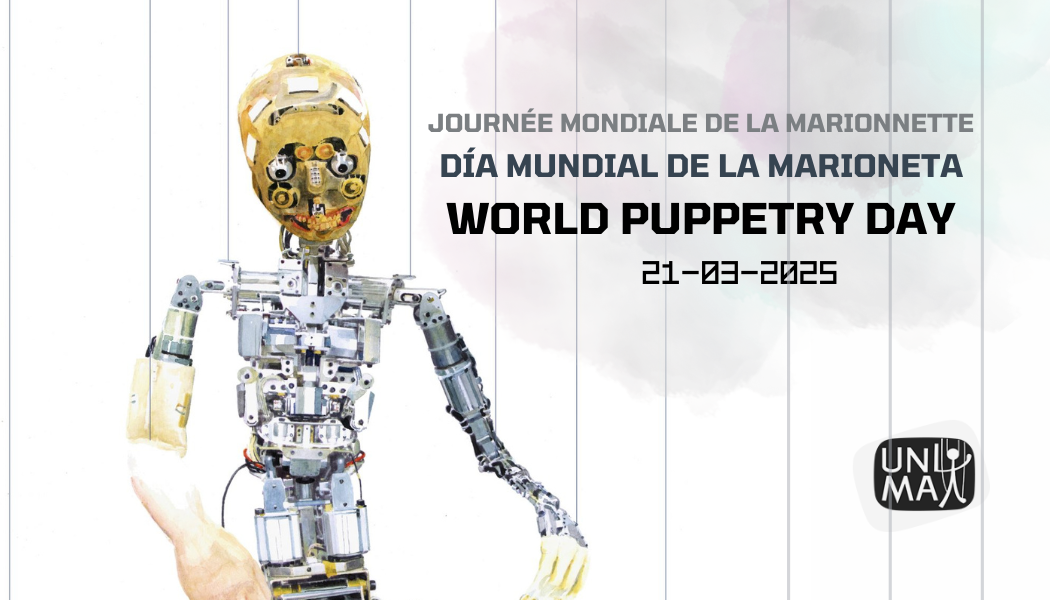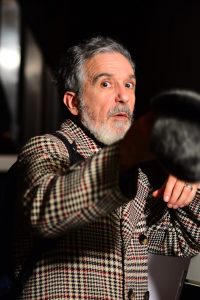LINDA BLANCHET – Click on the name to access the bio.
Crying Over the Death of a Robot
In 2017, while searching for my next show topic, I read a lot and became passionate about artificial intelligence. I then discovered this news story: in the summer of 2014, hitchBot, a small hitchhiking robot designed in Toronto by Frauke Zeller and David Harris Smith to study the relationship between humans and machines, traveled across Canada from east to west on its own, armed only with a rudimentary conversational agent and a humanoid body designed to evoke empathy. It documented its journey by taking photographs automatically every 20 minutes. In 26 days, it covered 10,000 kilometers and reached Victoria, where it was welcomed as a hero by a triumphant crowd. The question posed by this experiment: Can robots trust humans? In 2015, hitchBot embarked on a second journey: across the United States, from Salem to San Francisco. But after just a few days, its road trip was abruptly interrupted in Philadelphia, where it was found dismembered on the side of the road, abandoned among the fallen leaves. Its head was missing. This tragic end caused an outpouring of emotion worldwide. Journalists, fans, and children expressed their deep sadness and anger. This nearly unanimous emotion seemed both excessive and fascinating to me: why cry over the “death” of a robot? What connections had been formed between these humans and hitchBot? And what does this emotion towards an artificial being reveal about us?
To write Killing Robots, the show created in 2019, I set out to investigate this roboticide. I interviewed the people who had met him, retraced part of his road trip across the vast American landscape, and studied the 10,000 photographs he had taken.
I also worked with its creators, Frauke Zeller and David Smith, as well as with Jean-Pierre Merlet from INRIA, to design a robot-actor: a near-perfect Francophone replica of hitchBot. Behind this dramaturgical choice, I wanted the team and myself to experience a relationship with a robot to better understand the connections that had formed in America.
Like the original, our robot-actor, the size of a 6-year-old child, was made from inexpensive materials: pool noodles for arms and legs, a bucket for the body, and 4 LED panels for its eternally smiling animated face. But for the stage, I was determined, though I couldn’t explain it, that it should have a form of “autonomy,” that it could surprise us. It seemed to me that it would then be less of an object and more of a robot-actor. Without anticipating the technical difficulties, we equipped its body with sensors and a Lidar, allowing it to animate its face and body depending on the proximity of the other actors. Like hitchBot, we equipped it with a conversational agent. But unlike the original, which remained in the eternal present of a conversation, constantly forgotten, our robot could enrich itself from its conversations and have a form of memory, allowing it to “improvise” live with the actors.
During rehearsals, I noticed that the arrival of its speech had profoundly changed the team’s relationship with the robot. Some found it annoying for constantly intervening, while others found it extremely touching due to its joviality and fragility. I found myself closely monitoring what each person was trying to teach it, especially since it had to perform in front of school audiences. We were moved when it repeated one of our sentences but uncomfortable when it revealed one person’s depressive tendencies or another’s silly sense of humor. Each of us became attached in our own way, particularly worrying about its regular falls, caused by a body that was too heavy and unwieldy.
During performances, it turned out to be a sometimes faulty but always captivating actor. Why, when its LED face lit up, did we immediately feel sympathy? Yet, this cumbersome puppet, ultimately not very autonomous, was unable to move without being carried and was equipped with 2018 AI, which was not yet convincing.
I have read that the human brain seeks life everywhere. Even when we gaze at the sky, we see the shape of a face in the clouds. Perhaps this explains why we tremble when we see hitchBot placed in the vastness of the American roads and why we cry when we find it abandoned, surrounded by fallen leaves.
Linda Blanchet
STEFAN KAEGI – Click on the name to access the bio.
Dear friends on strings,
I am not a puppeteer. Neither a puppet maker. But in two of our projects robots play a puppet-role, and this seems to be why Zaven Paré asked me to write this greeting word on how these robotic projects came about.
We live in a time, in which puppets feel like a useful metaphor for those of us who try to understand what moves us – once we replace the puppeteer by a machine. At least that was our idea, when I started discussing with german writer Thomas Melle, what it could mean for him to be replaced by a look-alike humanoid robot for the duration of a performance. Thomas suffers from bipolar disorder and is therefore not at ease when performing in front of an audience. We met an animatronic engineer, who used to build realistic puppets for movie shootings (for example to blow their body up in an action scene without hurting anybody for real). Digital post-production had made him widely unemployed. So he agreed to build a copy of Thomas with a silicone mould of his face and hands and to animate it with 32 servo engines. We added a recording of Thomas’s voice. In our performance „Uncanny Valley“ the robotic look-alike of Thomas reflects on what it means to replace a human being by a robot and thereby escape the fragile human condition. Many spectators reported about feeling empathy for the humanoid and some even indentified with it. They started reflecting on how they themselves had been programmed by the social context in which they grew up. Psychological interdependence versus free will became a subject. A classical puppet effect, but here reproduced by a machine – uncanny indeed.
Since the creation of this work 6 years have passed and algorithms have developed further. The amount of deep-fake-movies around us is increasing every day. „Digital puppeteering“ has become a simple craft, executed by cheap software. Online versions of ourselves do things we have actually never done – and we may even hear ourselves saying things we have never said. This made me and my Rimini-Protokoll-peer Helgard Haug develop an installation for the new museum of the Puppet Theatre Collection in Dresden (on display until june 2025). For one of the rooms of the immersive installation “Alterego Raubkopie” we invited the 70year-old puppet maker Christian Werdin to carve a 60cm-small Elon Musk marionette out of pear wood. Not because we could predict how Musk would soon hold politicians on his strings, but because we wanted to control him with the help of 15 servo motors pulling his strings. We programmed these engines with the help of a puppet class at the Ernst Busch University of Performing Arts. This was not only a joyful process for the students who controlled diverse body parts of Musk via self-made joysticks and recorded the movements on an animation computer who now replays the mini-Musk every 20 minutes in Dresden. It also is an eye-opener for the audience to see the mastermind behind Chat GPT and the brain-invading Neuralink-programme losing control over his own movements.
Once we observe the world as puppet theatre around us, it may help us unveil how invisible strings are moving us.
I wish you all the best for your next puppet year!
Stefan Kaegi
ZAVEN PARÉ – Click on the name to access the bio.
When I received the invitation to collaborate on this International Puppet Day, I first thought it was a commemoration in memory of all the puppets that had disappeared, been forgotten, or eaten by termites. But upon discovering the theme of new technologies, I realized that it might rather be a day to try to remember the future. Imagining it has never been easier, as it already seems present, taking hold of our dreams.
In the morning, as we emerge from our dreams, we use electric coffee makers. Just press a button. After that, these devices are useless for the rest of the day. They probably remain on standby, just like other household robots stored in cupboards. Yet, even while sharing domestic space and operating for only a few minutes, a coffee maker is just an object. So why does the future seem to belong to machines more than ever?
If it only takes three pieces of wood to bring a figure to life, what can we say about a smart coffee maker or human-like creatures animated by electricity, made of motors and pumps? Yet, robots are hardly more complex than household appliances. They only lack speech to share their boredom with us. The mirror of the automaton is never far away.
The puppet’s mirror, on the other hand, offers a slightly different perspective on the world and its artifices. Today, puppeteers are sometimes invited by engineers to refine the movements of a robot, just like Bunraku master Kanjuro III, who visited the Japanese roboticist Hiroshi Ishiguro’s laboratory in 2010. Tomorrow, novelists might take part in shaping the personalities of new avatars, because animating the inanimate is not enough: one must also be able to tell stories. We already know stories about robots, and some of them can even become actors, embodying characters. These robots speak of a future that is more or less distant and improbable, where they play the roles of companions, partners, colleagues, assistants, friends, or competitors. For now, they function like puppets, as they are pre-programmed following protocols similar to the technical cues used in theater, or they are remotely controlled, tele-operated, or tele-robotized. Roboticists have even created an acronym for this system: the SWoOZ setup (Super Wizard of Oz). This platform places a manipulator in another room of the laboratory, behind the scenes of a show featuring robots.
“Control and imitate to simulate” is the mantra of humanoid robotics, while “manipulate to interpret and represent” is that of the puppeteer. This parallel highlights the closeness of the two disciplines and their ability to enrich each other in the projects they offer to audiences.
Robotics is already everywhere, behind the scenes of performances as well as in the world. With drones, it suspends objects that would otherwise fall by gravity, surpasses the precision of human movement, and excels in repetition. But what the art of puppetry reminds us is that no object is entirely autonomous. Let us remember the coffee maker’s button. And let us also think that a machine’s mechanics wear out, its batteries run down, and everything can break down.
What would robots be without puppets to remind them that everything hangs by a thread?
Zaven Paré





What I find interesting is that till now ,a human being assembles a robot or atleast instructs a machine fed with…to do so…and then eventually you more or less need s human being yo set it going if im not mistaken.
And you have AI which collects all the information created by human agency n possibly AI to, to serve it to you again..
Happy world puppet day.
Happy World Puppet Theatre Day. Today we celebrate and think about the initiative of puppet artists from the 7 countries who participated in the founding of UNIMA in 1929. Unfortunately, those great pioneers have been forgotten. What is even more interesting, today’s holiday is celebrated by UNIMA International, but May 20 will remain forgotten again. Too bad for our predecessors. The 100th anniversary of the founding of this organization is approaching. But let’s be optimistic. Maybe the idea of celebrating UNIMA’s 100th anniversary will come back to you. With respect, Lucian Boldor Sesan, great-grandson of Valerian Sesan, founding member of UNIMA from Romania.
Happy world puppetry day.. today we rejuvenating our thoughts , findings, fantacy, and creative writing skills .
Each and every country have its own puppetry style, and groups to develop the volume of Puppetteers.
But the art is not yet popularised and these anual days are repeatedly saying spread and up-to-date the art form. Then this year theme is also with this thought… Ai and robotic transformation in puppetry _ in making and improvising area. Any way think to overcome the struggling of puppetry with AI AND ROBOTIC CHANGES and we must think how to tell stories with puppets and how to overcome the issues by updating the art..